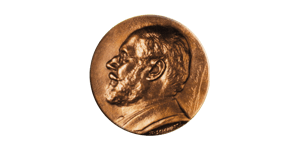 Sell tickets and manage registrations
Sell tickets and manage registrations
 View my tickets and registrations
View my tickets and registrations
 Sell more tickets through digital marketing
Sell more tickets through digital marketing
 Add an event calendar to your website
Add an event calendar to your website
 Find events by location and categories
Find events by location and categories
2018 Exner Lectures

@ Palais Eschenbach, Eschenbachgasse 11, 1010 Vienna, Austria
Program:
Day 1 – October 23rd, 1:30 pm – 5:30 pm
1:30 pm
Registration
2:00 pm
Lectures honoring the Wilhelm Exner Medalists
Thomas Jenewein and Gregor Weihs

„Photonic Quantum Entanglement for Technologies and Applications: Towards the Quantum Internet“
Thomas Jennewein, University of Waterloo, Canada (
„Semiconductor nanostructures producing single photons, twins and triplets for quantum photonics“
Gregor Weihs, University of Innsbruck (
3:15 pm
– 3:45 Coffee break

„From local realism into a global quantum age“
Hannes Hübel, AIT Austrian Institute of Technology, Vienna (
„Quantum Information Processing with Superconducting Circuits“
Gerhard Kirchmair, University of Innsbruck (
„From quantum foundations to quantum computing“
Philip Walther, University of Vienna (
5:00 pm
Closing Remarks
Day 2 – October 24th, 8:30 am – 1:00 pm
8:30 am
Registration
9:00 am
Lectures honoring the Wilhelm Exner Medalist
Zhenan Bao

„Skin-Inspired Electronics“
Zhenan Bao, Stanford University, USA (

"Ferroelectric Polymers for Sensitive Object Surfaces"
Barbara Stadlober, Joanneum Research, Graz (

„Biosensing technologies for medical diagnostics at the point of care“
Rainer Hainberger, AIT Austrian Institute of Technology, Vienna (
10:30 am
Coffee break
11:00 am
Lectures honoring the Wilhelm Exner Medalist
A. Paul Alivisatos

„Quantum Dot Light Emitters: From displays to enabling a new generation of energy conversion systems“
A. Paul Alivisatos, University of California, Berkeley, USA (

„Rational Design of Thermoelectric Materials from Nanocrystal Building Blocks“
Maria Ibañez, Institute of Science and Technology Austria, Klosterneuburg (

„Energy conversion and energy storage by moving ions in solids“
Jürgen Fleig, University of Technology, Vienna (
12:30 pm
Closing remarks
- - - - - - - - - - - --
For questions mail us: info@wilhelmexner.org
- - - - - - - - - - - --
Abstracts: (to be completed soon)
"Photonic Quantum Entanglement for Technologies and Applications: Towards the Quantum Internet"
Thomas Jennewein, University of Waterloo, Canada
Quantum information processing and quantum communication are novel protocols that originate in the very fundamental and philosophical questions on superposition and entanglement first raised about 100 years ago in the early days of quantum mechanics. Strikingly, these new protocols offer capabilities beyond communication task possible with classical physics. One very important example is the secure key exchange based on the transmission of individual quantum signals between communication partners. The big vision and frontier in the field of quantum communication research is the development of a Quantum Internet, which establishes entanglement between many different users and devices. The basic idea is that similar to today’s internet, the Quantum Internet will readily transfer quantum bits, rather than today’s classical bits, between users near and far and over multiple different channels. This Quantum Internet could be useful for secure communications, quantum computing networks and metrological applications such as better time keeping or enhanced telescopes. I will discuss recent advances on implementations and tools useful for generating and distributing photonic quantum entanglement, as well as our work towards the Canadian quantum satellite mission, QEYSSAT, that will demonstrate transmission quantum signals from ground to space in the goal to cover global distances.
"Semiconductor nanostructures producing single photons, twins and triplets for quantum photonics"
Gregor Weihs, University of Innsbruck
While photonics is an established area of technology covering optical communication, manufacturing, sensing, and many other fields of application, hardly any of its methods actually make use of the quantization of light. Quantum photonics applications, on the other hand, explicitly build on the quantum properties of light to realize secure key distribution, optical quantum computing, and quantum computer networks.
Sources of quantum states of light are important building blocks of such quantum photonic systems. Traditionally these sources were realized using nonlinear optical techniques in conventional optical laboratory setups but for any real world applications, it is clear that we need to achieve miniaturization and integration. In our work, we employ single semiconductor quantum dots, nanowires, and waveguides to implement sources of single photons, entangled photon pairs and even triplets of photons. While there are still many open research questions, these sources have the potential to make quantum photonics a practical reality.
"From local realism into a global quantum age"
Hannes Hübel, AIT Austrian Institute of Technology, Vienna
In this talk I will review the concept of entanglement, how it radically changed our understanding of the world we live in and its usage in quantum communication applications. Quantum key distribution (QKD) will be highlighted as one of the most technologically advanced application of quantum communication. There I will discuss current trends to incorporate QKD into telecommunication networks together with advances on photonic integration that will allow QKD to achieve a widespread use from industrial players to home users.
"Quantum Information Processing with Superconducting Circuits"
Gerhard Kirchmair, University of Innsbruck
Superconducting quantum circuits are one of the most promising platforms for realizing a quantum computer. In this talk I will present some of the research activities of the Superconducting Quantum Circuits group in Innsbruck. I will give a short introduction to circuit quantum electrodynamics and highlight the progress of superconducting qubits. I will then show, how this architecture can be used to realize a platform for quantum computation and for simulating interacting quantum many-body systems.
„From quantum foundations to quantum computing“
Philip Walther, University of Vienna
This talk reviews the impressive pioneering work in quantum photonics up to the current stage of photonic quantum computers. The advantages of photonic systems have not only enabled fundamental experimental investigations of quantum physics, but have also led to novel applications such as quantum computing and even quantum cloud networks. The talk will finish with a brief overview of special-purpose quantum computers whose applications are uniquely suited to optics.
„Skin-Inspired Electronics“
Zhenan Bao, Stanford University, USA
Skin is the body’s largest organ, and is responsible for the transduction of a vast amount of information. This conformable, stretchable, self-healable and biodegradable material simultaneously collects signals from external stimuli that translate into information such as pressure, pain, and temperature. The development of electronic materials, inspired by the complexity of this organ is a tremendous, unrealized materials challenge. However, the advent of organic-based electronic materials may offer a potential solution to this longstanding problem.
My group has been working on understanding of the fundamental design principles of new electronic materials that have skin-like properties, such as stretchability, self-healing ability and biodegradabaility while maintaining excellent electronic properties. We realized artificial skin with sensitivity and stretchability comparable to that of human skin. We demonstrated artificial mechanoreceptors and artificial nerve systems. In turn, the basic inventions of materials and devices enabled a new generation of skin conformal electronics that can be used for health monitoring wearables, wireless and biodegradabale implantable sensors for tendon repair and neuroprostheses.
"Ferroelectric Polymers for Sensitive Object Surfaces"
Barbara Stadlober, Joanneum Research, Graz
Ferroelectric polymers from the PVDF-family have proven to be multifunctional and self-sustaining materials with a broad application range in printed and flexible electronics. They can be used for detecting dynamic and static mechanical excitations such as pressure or force, touch, impact and strain, for sensing human-body radiation and proximity, as vibration sensors for structure-bourne sound detection, as seamlessly integrated acoustics devices, as stretchable vital parameter sensors for movement, ECG and respiratory rate monitoring, as well as piezoelectric energy harvesting elements. Last but not least PVDF-based fluoropolymer can also be used as actuators. These rich properties promote the deployment of ferroelectric polymer sensor and actuator films for sensitive object surfaces within IoT scenarios, especially if they can be processed on versatile, flexible and lightweight substrates of 2D or 3D format at low-costs (e.g. by printing) and over large areas.
„Quantum Dot Light Emitters: From displays to enabling a new generation of energy conversion systems“
A. Paul Alivisatos, University of California, Berkeley, USA
Nanoscience has provided a new approach for designing materials that absorb and emit light and transport charges efficiently. These are fundamental steps that underlie many energy conversion technologies. This presentation will focus on colloidal quantum dots, and how they can be made to absorb and emit light, as well as to transport charge efficiently. When the principles of nanoscience are used to prepare a small piece of semiconductor that is fully isolated from the environment,
it can behave as a nearly ideal light absorber and emitter. These “quantum dots” have now left the lab and moved into practical use, as they are widely used today in a new generation of extremely energy efficient displays that provide exceptional color purity. The efficiency of light emission from these quantum dots is so close to unity that it is actually requires new approaches to measure accurately. This in turn has prompted us to investigate what happens when quantum dot light emitters approach the thermodynamic limit of their luminescence efficiency. This talk will describe some entirely new energy conversion processes that may be enabled for the first time by using such nearly ideal light emitters. If time permits, I will also describe recent work on a new approach to extremely efficient ultrafast charge transport in quantum dot films.
"Rational Design of Thermoelectric Materials from Nanocrystal Building Blocks"
Maria Ibanez, Institute of Science and Technology Austria, Klosterneuburg
Nanocrystals can be envisioned as artificial atoms to build-up materials from. Colloidal synthetic routes are capable to yield nanocrystals with precise control of size, shape, crystalline phase and composition, thus allowing to accurately engineer such artificial atoms. Beyond nanocrystal design, another key player on the building-up process is the nanocrystal surface. The possibility to modify nanocrystal surface chemistry opens a new degree of freedom to tune final nanomaterial properties, defining the surface ligand as a building block on its own. Last but not least, the functional properties are as well determined by the nanocrystals organization, interconnection, packing density and relative crystal orientation in the final nanomaterial. Herein, we will focus on the synthesis of nanoparticles with precisely engineered composition and surface chemistry, and their combination and consolidation into nanostructured materials to target the needs of thermoelectricity.
"Energy conversion and energy storage by moving ions in solids"
Jürgen Fleig, University of Technology, Vienna
Improved and also novel approaches are required for chemically storing electrical energy and for efficiently converting chemical and electrical energy. Moving and reacting ions in solids play an essential role in those technologies. State of the art rechearchable lithium ion batteries, for example, rely on the motion of ions in electrodes and future improvements can be expected from exploiting also ion transport in solid electrolytes. Power to gas technologies such as electrolysis of water can strongly benefit from highly mobile and reactive ions in solids and the same is true for fuel cells used for efficient chemical to electrical energy conversion. Moreover, ion motion can be triggered by interaction with light, which may open novel paths to energy storage but can also hamper operation of devices, e.g. perovskite solar cells.




